What about now?
—————-
By Beppe Colli
Sept. 3, 2015
Sometimes I think about the enormous quantity of music I
"discovered" – better said, I was exposed to – in the years
1970-1972. Which, by itself, is not something too extraordinary, given the enormous
quantity of good music one could listen to at the time. What I’d like to stress
is that I was able to listen to all that music by simply turning my radio on in
the afternoon – to be more precise: from 4 to 6 pm. I have to add that at the
time RAI – the state-owned media company – had a complete monopoly over all
radio and TV broadcasting: three radio and two TV channels were all there was.
Let’s see how many artists and groups I can
remember listening to while I was doing my homework.
First of all, the three giants of the type
of music that today – many years after the fact – is labeled as
"Progressive": Yes, Genesis, and Emerson, Lake & Palmer. By
association, three groups that were big in Italy, but not in their homeland:
King Crimson, Van Der Graaf Generator, and Gentle Giant. The "hard
rock" of such groups as Deep Purple, Black Sabbath, Grand Funk Railroad,
and Uriah Heep. Groups that were famous all over the world, such as Ten Years
After, Santana, and Chicago. Former Beatles still flying high in the charts as
solo artists: George Harrison and John Lennon. The Who at the time of Live At
Leeds and Who’s Next. The colossal Led Zeppelin (all their albums, including
such bootlegs as Live On Blueberry Hill). Pink Floyd, in their pre-The Dark
Side Of The Moon days. Procol Harum, Moody Blues, Family, and Colosseum. Lotsa
Blues from John Mayall. The Rolling Stones at the time of Sticky Fingers and
Exile On Main Street. Singer-songwriters such as James Taylor, Elton John, and
Cat Stevens. Jethro Tull’s Aqualung and Thick As A Brick. Curved Air and
Audience. Crosby, Stills, Nash & Young, both as a group and as solo
artists. David Bowie’s Hunky Dory and The Rise And Fall Of Ziggy Stardust And
The Spiders From Mars. Traffic’s John Barleycorn Must Die and The Low
Spark Of High-Heeled Boys. "English Folk" by Pentangle, Incredible
String Band, John Martyn, and Nick Drake. A pinch of Frank Zappa. "New
Italian Groups" such as Premiata Forneria Marconi, Banco del Mutuo
Soccorso, le Orme, gli Osanna, i New Trolls. More Italian names that maybe I
decided to forget. And a lot more that I can’t seem to remember right now.
During the Summer, the rationale that young
people had more interesting things to do than listen to the radio made it
possible for radio programmers to broadcast lengthy tracks by Frank Zappa, off
Hot Rats; by Miles Davis, off Bitches Brew; by Cream, off Wheels Of Fire; also
assorted tracks by Weather Report and Mahavishnu Orchestra; Doors epics such as
When The Music’s Over; also, Johnny Winter’s amphetamine Blues, recorded live
on stage.
The avalanche did not end in 1972. I
remember news getting more space in the afternoon slot, while more
"difficult" music was now broadcast at night, with lotsa space given
to artists such as Robert Wyatt, Gong, and so-called "Canterbury
Groups" that up to that time had been under-represented on Italian radio.
I hope readers won’t think that I regard
the above-mentioned names as my proposal for a "best music of all
time" chart. What I want to stress is the great stylistic variety of those
strains of music that were broadcast side-by-side, one after the other. Also,
many of those pieces were quite long, something which at the time was not
perceived as being "not appropriate" for radio. Quite a few "hit
albums" were broadcast in full – not in one shot! – and I clearly remember
listening to what amounted as complete albums, such as Fragile by Yes; Emerson,
Lake & Palmer’s first album of same name; In Rock by Deep Purple; Three
Friends by Gentle Giant: all albums I knew note-for-note while never owning a
copy (also Tarkus, Machine Head, Octopus…).
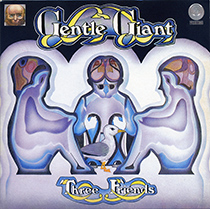
At the time, such tracks as Take A Pebble could widen one’s horizons. And I bet not many people would believe today that such albums as King Crimson’s Lizard and Islands were "radio hits". Also, that long, difficult tracks such as Man-Erg, Pantagruel’s Nativity, and The House, The Street, The Room were constantly in "heavy rotation" in the afternoon.
Readers are invited to think about the peculiar kind of attitude listeners would develop with regards to their attention spans when listening to "difficult" music; also, their attitude about forking real money as compensation for what they regarded as possessing great value.
Readers are now invited to perform a very simple experiment: listening to the Gentle Giant album titled Three Friends, then pondering the fact that those six pieces were broadcast many times, full-length, in the afternoon slot from 4 to 6 pm.
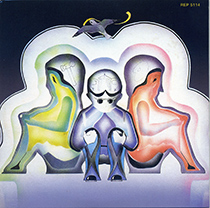
It’s my opinion that in the 80s and early 90s US music monthly Musician was the best music magazine in the world. Since my personal criteria don’t include any kind of distinction between "technical" and "non-technical" magazines, I’d put Musician alongside such high-quality publications as Guitar Player and Keyboard. At first called Musician – Player and Listener, the magazine soon shortened its name to Musician. A name that means a lot, implying such qualities as "skill" and the famous dictum that mentions both "inspiration" and "perspiration" (how different the name – and the philosophy behind! – The Face).
I clearly remember the pleasure I felt when I found that most articles and reviews that appeared in Musician were of a very high quality, regardless of the "genre" of music and the amount of popularity of the artist. This is a point that can appear as being redundant, so I’ll be clear. I’ve often noticed that while I highly prize reading "something of substance", most people regard reading "something about artists whose music I like" as being the best.
(It goes without saying that here it could be said that "reading something of substance about artists one likes" is obviously preferable; unfortunately, things are seldom so simple!)
So it has often happened that my observation "magazine x really stinks" was rebutted by a reply along the lines of "well, it talks about artists whose music I like".
While I’ve always considered learning something that was true and valuable as the most desirable trait when reading a music magazine.
The fact of Rolling Stone becoming less of a "music magazine" and more a "celebrity magazine" that dedicated a lot of space to people who worked in movies and on TV, offered a big chance to Musician, which now was able to offer a lot of space to artists who were in a higher commercial bracket but who were quite happy to be interviewed by serious writers who asked serious questions.
For instance, at the time this was definitely not your average magazine cover.
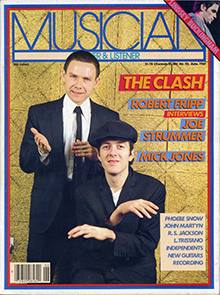
But in order to fully appreciate Musician’s scope, have a look at the "window" to the right.
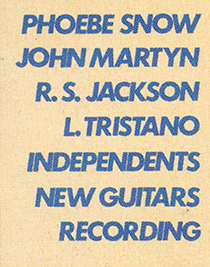
Let’s also have a look at this cover, which paired an artist whose popularity at the time was of the "highly selective" kind – Captain Beefheart, the piece about him being penned by Lester Bangs – and one of the most famous voices of the day on American radio: Michael McDonald of The Doobie Brothers.
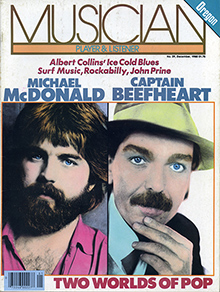
Sure, we all know about the strategy of pairing a commercial name and a critics’ darling. But here the surprise is that – of course, finding such a long piece about Captain Beefheart is never easy – the long interview with Michael McDonald is just as good as the one with Captain Beefheart.
It was quite surprising to read a list of mentors and inspirations which included Burt Bacharach, a legendary musician who at the time was considered by many as a "has-been". Opening one’s ears, it was not impossible to find traces of Bacharach in such colossal Doobie Brothers hits as It Keeps You Runnin’ and What A Fool Believes, both written and sung by Michael McDonald. But who would have thought about Bacharach being an influence on him? And so, after reading the interview, I was left with a lot of sound, reliable information to explore. (Let’s also think about the very different meaning of the expression "Bacharach-influenced" when related to 80s artists whose only specialty were "60s moods" like the ones one used to find in ads for wines and liquors.)
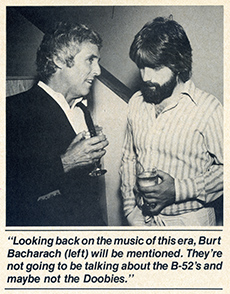
It appears that quite a few people, including critics, found the recent Paul Thomas Anderson movie Inherent Vice – off the Thomas Pynchon novel of same name – quite difficult to "get", and "walked out".
I could say that starting from the days of classic "noirs" such as The Big Sleep and The Maltese Falcon not all threads add up in the end with impeccable logic. I could argue that Inherent Vice is a "stoner" movie, where logic travels very peculiar paths. I could also argue that – in so differently from a book – a "story" is not the whole movie, visuals and cinematography incorporating their own specific kind of "narrative".
Anyway, Inherent Vice is not Syriana, a movie where the main difficulty is keeping in mind all the pieces of a puzzle that in the end – and only then – reveals the links that connect stories that up to that point appear as being totally unrelated.
One has to keep in mind the meaning of the expression Inherent Vice, a legal notion with obvious connections with the realm of insurance, as explicitly discussed in the movie.
And so, by pondering the words "Inherent Vice" we get closer to the truth: What is the "inherent vice" the movie talks about? What "object" is "at fault"? What was "bound to end badly" due to an "inherent vice"?
There’s a lot to investigate. For instance, one important aspect of the movie deals with the many ways one can become a servant, a minion. There are those who become servants voluntarily. There are also those who fulfill their very nature by becoming "a thing" in the hands of others, with no will of their own. And this, I guess, is not too difficult to get, you dig?
© Beppe Colli 2015
CloudsandClocks.net | Sept. 3, 2015


